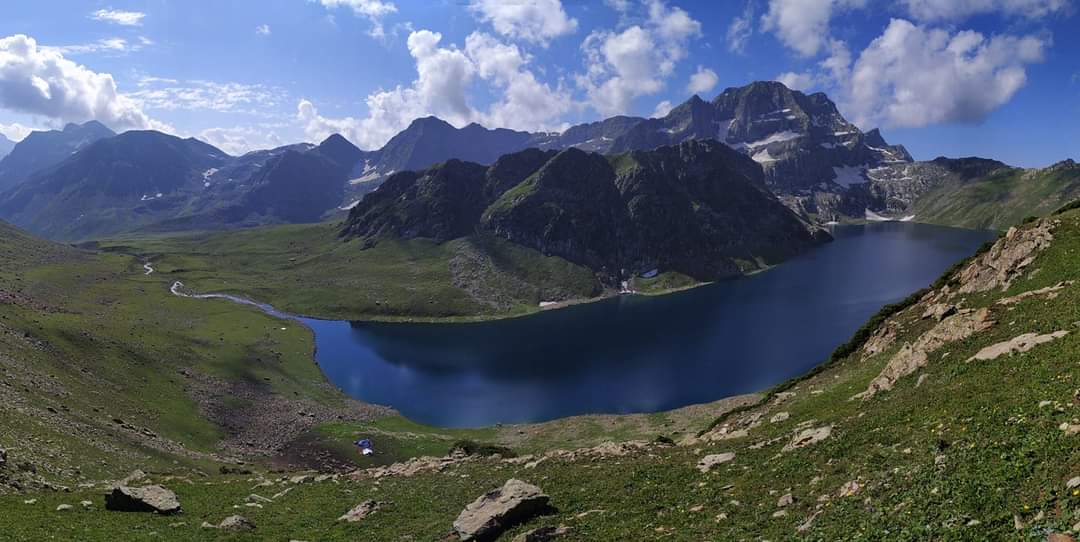Tarsar Marsar Trek

Tarsar Marsar Trek
The lakes of Tarsar, Marsar and Sundarsar
The Tarsar Marsar trek is in Kashmir. Trekking in Kashmir is very different from trekking anywhere else in our country. Nowhere else do you get to trek next to such spectacular alpine lakes. On this trek, you get to camp beside two such beautiful lakes – Tarsar and Sundarsar.
The spectacular meadows of Kashmir
The beauty of the Tarsar Marsar trek does not end with the lakes. The meadows of Kashmir are something to look out for too. On this trek, you find these exquisite meadows on every day of the trek. The forests, clearings and woods surrounding these grasslands make them come alive even more. Sometimes, as trekkers you move from one meadow to another separated by just a patch of forest.
Day 1: Trek from Pahalgam to Aru to Lidderwat
Altitude: 7958 feet to 9131 feet Distance: 10 kms Time taken: 6 hours Trail type: Gently climbing long trail It is a gentle but long climb from Aru to Lidderwat covering a distance of 10 km in 6 hours. The trail to Lidderwat starts to climb straight out of the village, following the course of the Lidder River. Follow the wide trail past the agricultural department’s fence. Look back to take a commanding view of the entire region of Aru. The trail gets into a cluster of fir trees and continues to climb. Half an hour later, the trail pops out at a clearing called Dalla near Gujjar huts. Out of the pine trees, the trail gently climbs a mound, from the top of which is one of the most fascinating sceneries of the day. The Lidder River meets with the trail at the valley bottom, spreading out in springs. Next to the river are grassy glades where the trail runs. Beyond, the Lidder rushes out of a curve around more gorgeous fir forests. It takes about half hour to cross this lovely section of the trail and enter the cluster of firs once again. Across the forest and ten minutes later, are the superb meadows of Lidderwat. There are a few Gujjar huts that signal Lidderwat. A sensible option is to drop down to the wooden bridge, climb out of the meadows on the other side and camp anywhere. On the other side are lovely clear streams running across the meadows – this is vitally important if you are camping for the night. Pahalgam District Authority huts for accommodation. There are also plenty of places to pitch camp.The Lidderwat camping site is a dream. Clear streams run across the meadows. Spare time to take long walks that stretch to either ends of the meadows.
Day 2: Lidderwat to Shekwas
The trail to Tarsar starts to climb right behind the PDA huts – following the course of the river flowing alongside. It leaves the river below and climbs very quickly into the pine forest above you. The trail is straightforward and does not pose any challenge.Continue to climb past clusters of pines and clearings for an hour and a half, until a stunning view opens up before you. The narrow valley of Lidderwat opens up to tracks of wide sweeping grasslands. The grasslands merge with the towering mountains, with snow patches in their folds. It is no longer a single valley but many valleys that converge together. The trail ahead converges upwards and to the left past the Bhakarwal shelters, sticking to the right of the river.
Clear streams run down and cut through the trail many times. There are good spots to fill water. Avoid taking the upward trail. Drop down to the river and cross it, first hopping over a few boulders and then crossing a make-shift long bridge. Follow the river and continue to climb the trail. Half an hour later, the trail around a bend opens up to a wide clearing of Homwas.
There are a few friendly Gujjar huts where you can stop for tea. It is a delight treading on the trail after Homwas. It is mostly on grass and feels lovely under your feet. The trail, now in a south westerly direction, enters a narrow valley with blue waters of the river as constant company. The climb continues to gain altitude. An hour later, you will pass a very old cluster of Silver Birch (Bhoj) trees, and the view opens up to another stunning scenery.
This time, a possibly wider grassland leads to two wide green valleys. It stretches out vastly in front of you. Undulating meadows on your left reach out for the sky. Beyond the meadows, tall, dark, snow-patched cliffs shadow the landscape. The trail climbs swiftly past a few Gujjar huts to the camping grounds of Shekwas. For those on the Tarsar trail, Shekwas is a logical and extremely pretty camping ground. It is a good break after the hard climb.
Day 3 Shekwas to Tarsar
Past Shekwas, the trail again snakes its way through grass for a long while. The trail to Tarsar, meanwhile, climbs into a ridge that overhangs the stream. In a general westerly direction, the trail climbs rapidly towards a conical hill in front. The trail tops a few false ridges, each opening up to different wondrous sceneries.Two hours later, the trail finally gives you a narrow glimpse of Tarsar. Even the slight glimpse is a delight and it is a rush to reach the shores of the lake. Cross the stream over boulders and set your foot on the grassy glades of Tarsar. There are plenty of flat camping spots along the lake and pitching tents is not an issue. The lake is a stunning display of nature’s capabilities. The waters are turquoise blue and in a cauldron surrounded by snow patches feeding the waters of the lake. If ever there was a place that could come close to paradise, then the camping shores of Tarsar are it!
Day 4 Tarsar to Sundersar
The view from the other side of the Tarsar pass is another terrific attraction. The grassy valley stretches out from your left to right in a never ending stretch of beauty that boggles the imagination. Even the anticipation of your walk on the valley floor is enough to set the heart racing. On a side note, this is the same valley that leads to the Shekwas meadows. Most trekkers descend down from Tarsar, until Shekwas, turn left and get into the Sundarsar valley. By climbing to the pass you’ve saved 3-4 hours of the trek.
Descend from the pass on the shepherds’ trail that leads to the bottom of the valley. Catch up with the trail that runs along the stream on the grassy bed of the valley. Move up the valley, to your left and continue on the trail. Ten minutes later, spot a few Bakkarval shelters on your left. Behind the shelter, the trail climbs over a short stretch of boulders to tap a knoll.
What lies behind the knoll is something that poets reserve their best for. In a vast expanse of meadows, with a widening valley on your left, are the most lush grasslands you’ll ever see. Sheep graze gently on the meadows. Unmindful of your presence even as you brush past them. Horses munch on the same grass in gay abandonment. In the middle of the meadows, the stream turns into a large pond, fed by brooks from snow-melt of the surrounding mountains. Snow patches on the mountains offset the greenery of the meadows.
This delight of nature takes about half hour to cross. Walk down the trails that lead to the end of the meadow. Towards the end, superbly laid boulders cover the stream. They are laid out so well that it appears as if they were constructed there. Hop along the boulders, climbing rapidly for another 15 minutes, until you reach the base of a ridge that separates the meadow from the valley above it. To get to the top of the ridge, the trail climbs through a narrow boulder-lined valley for another 15 minutes.
Topping the ridge is another moment for the poets. Another meadow larger than the one you left behind sprawls out in front. Which is more beautiful, it’s hard to say. The settings are similar, almost identical. The valley floor is a vast bed of flowers. Far beyond is another ridge top – the exit route of the Tarsar trek. From the ridge top, look to your left and spot a grazing trail that leads into the folds of the mountains on your left. The folds lead to enticing snow-laden flanks of mountain sides.
Follow the trail that climbs past the stream running down the slope. Briefly, the trail hangs over similar well-laid boulders over the stream. Ten minutes later, the trail magically hops over landscaped grassy mounds to land on the lovely shores of the lake of Sundarsar. To your right and behind, are big flat stretches for camping. Sundarsar is the perfect camping spot after the lovely trek from Tarsar.
Day 5 Visit Marsar and go to Homwas
From Sundarsar, skirt around the shores of the lake from the right to get to the far side of the lake. There are two logical passes that one can climb. Both lead to Marsar. The quicker one is over the boulder-laden trail on the left. Climb over the boulders and trace a path towards the pass. Snow over the boulders can make the approach tricky. An ice axe or a trekking pole helps a lot to gain firm footing. It is a half hour climb to the pass. The pass is a lovely grassy stretch that has clear trails leading to flatter grounds just below it. Get down to the flatter stretches and occasionally hop over lovely brooks that run along the trails. Keep to the trail that veers to the left and spot a ridge that climbs on your left and in front.
Five minutes later, climb over to the top of the ridge for an amazing view of Marsar almost 600-700 feet below. Marsar is a hidden beauty, almost always engulfed under dollops of clouds and mist. Almost as large as Tarsar, Marsar is similar looking. Tall, snow-lined cliffs rise off the lake. On the left, the overrun waters of the lake run down a lovely green valley towards Traal. On the right, outer edges of the Dachigam reserve forest almost climb up to the shores of the lake. Head back the way you came up to Marsar and get back to Sundarsar in about 40 minutes of descent.At Sundarsar campsite, you have breakfast and start from Homwas. You retrace your steps to Jagmargi valley. Trekkers are extremely lucky to view these grasslands twice and from different directions. Instead of crossing the Tarsar pass, you take a different route to Shekwas. Roughly an hour of walking from Shekwas to Homwas. You are expected to reach Homwas just in time for lunch. You camp at Homwas for the night.
Day 6 Homwas to Aru.
Today you take the same route that you had taken at the beginning of the trek via Lidderwat. The trail goes downhill and it is a quick descent. It will take you 2 hours from Homwas to Lidderwat. The beauty of this part of your trek is that you will get to see all of those views that you had initially missed. The shrinking Kolahoi glacier is one of these sights. You will see the pine forests of Lidderwat that you had seen on day one of your trek in a whole new light. After getting some rest at Lidderwat, you head for Aru.
It is a 10 km walk from Lidderwat to Aru. This takes around 4 hours to cover. Stop for lunch en-route, you are expected to reach Aru by 4 in the evening.
